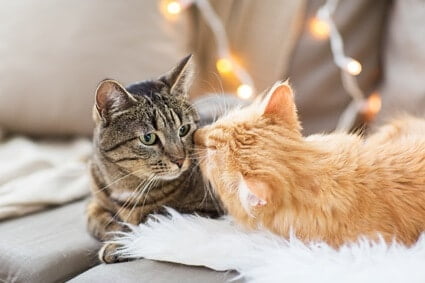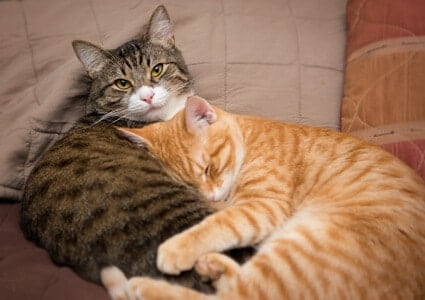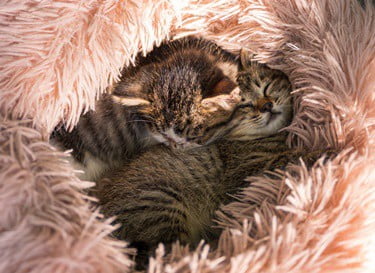Indoor cats are kept safe by a catio or specially made play area. This means that you might be concerned that your cat gets bored when you’re not there. So, should you get another cat to keep it company?
Whether indoor cats are happier in pairs depends on their personality. Some cats enjoy living alone and don’t get along with other pets. Others prefer having company. If you spend time away from home or don’t play with your cat enough, it’s at risk of getting bored. Consider getting a second cat if your cat has accidents outside of the litter tray, stops eating, vocalizes more often, becomes destructive, or seems unhappy. These are signs your cat’s lonely.
Choosing another cat isn’t an easy task. Your cats must be well-matched in personality so that they don’t fight or upset each other. As a result, try to find another cat of a similar age and temperament.
Do Cats Get Lonely Without Another Cat?
Whether cats get lonely without another cat or not comes down to their personality. Cats that are socialized to be around other animals or have friendly, playful personalities benefit from having another cat to play with.
However, if your cat’s gotten used to being on its own, introducing another cat into the household can be stressful and confusing. VCA Hospitals explains that most cats are hostile to unrelated felines and may not take to a new one at all. There are also many other factors to consider when deciding on a friend for your indoor cat. For example:
- How much time do you spend with your cat?
- How often are you away from home?
- Does your cat prefer to spend most of its time sleeping or playing?
- Does your cat appear lonely and sad by itself?
Unfortunately, there’s no one-size-fits-all answer to whether you should get another cat. You can only do the right thing for your cat and situation. In some cases, it’s not necessary to get a friend for your cat.
Is It Cruel to Only Have One Cat?
While most cats are social animals, they’re naturally solitary, so it’s not cruel to have only one. Wild cats form loose colonies where they share food and resources. They also split the care of the kittens amongst the adult females.
Even though this means cats enjoy having company, they form strong bonds with their owners, negating the need for other felines in the house.
However, it’s unfair on your indoor cat to leave it to entertain itself. If you spend extended periods out of the house at work or running errands and don’t spend enough time playing with your cat, it’s at risk of becoming bored and stressed.
On the flip side, cats that spend large amounts of time with their owners and frequently play with them are more likely to be happy enough to be the only cat. Depending on the cat’s personality, it may even prefer being a single pet. This is true if the cat’s:
- Anxious
- Aggressive
- Traumatized
- High maintenance
If your cat has any of these personality traits, introducing another cat into the home is risky. You could create a hostile, unpleasant environment for your new cat, which is unfair on both animals.
Indoor cat breeds tend to be calm and peaceful by nature, but they still need plenty of attention. Provide toys, games, and scratching posts to ensure your indoor cat receives enough mental and physical stimulation.
What Cat Breeds Are Okay On Their Own?
While cats shouldn’t be alone for too long, they are okay to be on their own for short periods of the day. Vets advise never to leave adult cats alone for more than 24 hours. When you are away from home, always ensure your cat can access fresh water, food, and clean litter. The following indoor cats are easy-going and happy to be kept alone:
- American Shorthair
- American Wirehair
- Maine Coon
- Norwegian Forest Cat
- Ocicat
- Persian
- Russian Blue
- Scottish Fold
Your cat’s personality may differ, so it’s essential you only take this list as a guide. Every cat’s different, regardless of its breed, so you might find that you get a cat breed that should be happy on its own on paper but needs more company.
Does My Indoor Cat Need a Friend?
To determine whether your indoor cat needs a friend or is happy enough to live by itself, invest in a home camera. These devices allow you to watch and observe your cat when you’re not there, enabling you to get a complete picture of its mood and activity levels.
When watching your cat, look out for any noticeable changes in its demeanor or general attitude. There are two likely scenarios:
- Your cat barely moves and sleeps all day. This indicates that it’s bored and has no desire to play, suggesting depression.
- It remains highly active throughout the day and becomes destructive, suggesting it has too much energy.
A happy medium, where the cat has short bursts of playtime with its favorite toys or wanders around the house to stretch its legs before settling down to sleep, is ideal. This scenario indicates that your cat’s happy on its own. If you notice signs of boredom or distress, it’s likely your cat needs some company.
How To Tell If Your Cat Wants Another Cat
It’s not always easy to know whether your cat’s lonely or needs a friend, so you’ll need to do some detective work to find out for sure. That’s why you should observe your cat’s behavior and mood to see if it’s showing symptoms of loneliness. Signs your cat wants another cat include:
Changes to Activity Levels
As soon as you get home after being away, check for signs of activity. If your cat’s destroyed your furniture or knocked items within the house over, it’s trying to entertain itself.
In comparison, if your cat’s bed or favorite sleeping spot is still warm, it’s likely happy to rest and conserve its energy while you’re away. This suggests that your cat’s OK on its own rather than in a pair.

Overgrooming
Lonely, bored cats overgroom to soothe themselves. As described by the Journal of Feline Medicine and Surgery, cats that excessively groom do so because they’re dealing with stress. Cats hide negative emotions well, so overgrooming usually betrays how they really feel.
In extreme cases of loneliness and boredom, overgrooming quickly turns to obsessive-compulsive disorder (OCD). Overgrooming becomes a ritual, and some cats only do it when they’re in the house on their own. This helps them deal with being alone. Getting your cat a friend to play with can ease this behavior and distract it from pulling out its fur.
Excessive Vocalizations
Some cats are naturally talkative, but if yours starts vocalizing more frequently, it’s trying to tell you something. In the case of loneliness and boredom, it likely wants more attention from you. If your once suddenly quiet cat becomes loud and talkative, it’s best to pay attention as something could be troubling it.
Try playing with your cat more often when you’re at home. If you entertain your pet during the hours you’re with it, it will spend the rest of the time sleeping and resting, negating the need for another animal. However, if your cat still seems stressed, it’s time to think about getting another cat.
Changes to Litter Tray Habits
Indoor cats use their litter trays to pee and poop because they’re not allowed outside. Because of this, they’re usually immaculate when they use their litter trays. So, when they start having accidents outside of the tray, there’s always a reason.
Before assuming stress, boredom, or loneliness, rule out any medical issues. For example, urinary tract and kidney problems are sometimes to blame. If your cat’s accidents aren’t medical-related, try to do some more digging to find out if your cat doesn’t like being alone by observing whether there are any other signs of boredom.
Aggression
Lonely cats become aggressive when their owners prepare to leave the house. That’s because they understand that they’re about to be on their own for an extended period of time. It’s easy to mistake this behavior for your cat being angry with you, but your cat could actually be encouraging you to stay because it doesn’t want you to go.
Destructive Behaviors
Like aggression, cats that don’t want to be alone become destructive, scratching at furniture and biting items around the house, such as cords. This will commonly happen when your cat’s on its own, leaving you with a mess to deal with when you get back home.
This isn’t only a sign of boredom and loneliness, but it’s a sign that your cat has too much pent-up energy. Indoor cats need an outlet to be active, which another cat can provide.
Unwillingness to Eat
Cats that stop eating are stressed. While medical issues are sometimes to blame, behavioral-related triggers are also a likely cause. This should only last a few days, but your cat may not gain its full appetite until you address its loneliness and boredom by providing more mental and physical stimulation.
It’s important to bear in mind that cats may stop eating once a new arrival enters the scene. Don’t be alarmed if you get a new cat any your original pet loses or doesn’t regain its appetite for a few days.
How To Choose Another Cat
Unfortunately, choosing another indoor cat for your pet to play with isn’t as simple as finding the one you like the look of best. Your cats must be well-matched to help them both feel comfortable and relaxed around each other’s presence.
It’s always easier to integrate your cats while they’re kittens. It’s even better if you can get cats from the same litter, as you won’t need to spend time introducing and socializing them with each other. However, if this isn’t possible and you already have an established adult cat, it’s time to pick the most suitable feline companion.
Another thing to bear in mind is that you’ll need your second cat to be an indoor pet. Letting one cat out but not the other will cause behavioral problems, such as jealousy. When choosing a new cat, consider:
- Personality and temperament. Ensure both cats are well-matched in character. They should have similar energy levels and behavioral traits.
- Age. If your original indoor cat’s old, try to find another cat of a similar age. Having a kitten alongside an older cat doesn’t always work.
- Gender. It might be worth getting a male and a female so that they don’t fight for dominance. However, remember to neuter both cats to prevent unexpected pregnancies.
Do your research before committing to another cat and ask plenty of questions to the owner about the cat’s personality. This will help you determine if they’re a good match.
How To Introduce Cats To A Household
If you’ve decided you’d like to get a second indoor cat to keep the cat you already have company, you’ll need to go through the tricky process of introducing them. This is rarely smooth sailing, so move slowly to give both cats a chance to get used to each other. To ensure this process succeeds, follow these steps:
Prepare the Items
Ensure both cats have their own items that they can call their own. This step is vital for introducing adult indoor cats or a new kitten to an adult cat, minimizing the risk of the cats becoming territorial. The items both cats will need include:
- A bed
- Food bowls
- Toys
- At least one litter box
If buying your cats separate items isn’t feasible, they can share – you’ll just need to watch them more closely to prevent early conflicts.

Set Up A Temporary Room
Set up a new room exclusively for your new cat and place the items in there. This will give it somewhere it can retreat to while allowing your already established cat to adjust to the new arrival.
Allow your original cat the chance to walk up to the door to sniff and investigate. However, don’t give it access to the room, as it could start a fight with your new cat.
If you don’t have a room you could use, you could bypass this step, but be sure to place both cats’ items at opposite ends of your living space so that neither feel threatened. Try not to leave your cats unattended and separate them if things ever get too heated.
Keep Your Resident Cat Calm
Keeping your original cat calm will help it adjust to the new arrival. You know your cat better than anyone, so use tried and tested tactics to keep it calm and happy. Cat-safe scents and pheromone sprays can help keep your cat feeling peaceful. Depending on its personality, brushing it and cuddling it can also help.
When you get to the point where you’re ready to introduce the two cats face to face, do it during a time when your cat’s at its most relaxed. This could be just before it settles down to sleep or after it’s eaten dinner. Keep the house quiet. If you suspect your cat’s becoming agitated, give it supplements designed to promote calm, including:
- Milk proteins
- Magnolia
- L-theanine
Introduce Your Cats
Before letting your cats loose in the same room, hold your new cat and let your original cat sniff it. Place your new cat in the temporary room and let it explore. Your original cat will need time to smell and investigate, but don’t let it wander on its own.
During this interaction, your cats may try to assert dominance over each other. As a result, expect hissing and swatting. Try not to intervene, though. They’re fine as long as your cats don’t start to become too aggressive toward each other, as this how they establish their boundaries.
Over time, they’ll become more giving and compromising in giving and taking boundaries. Don’t force the cats near each other and provide them with plenty of love and affection so that they don’t become jealous.
Whether you choose to have a pair of indoor cats or a single cat is a personal choice. However, your cat will let you know if it’s unhappy, so be sure to keep a close eye on its behavior and demeanor for any signs of stress, boredom, or loneliness.

